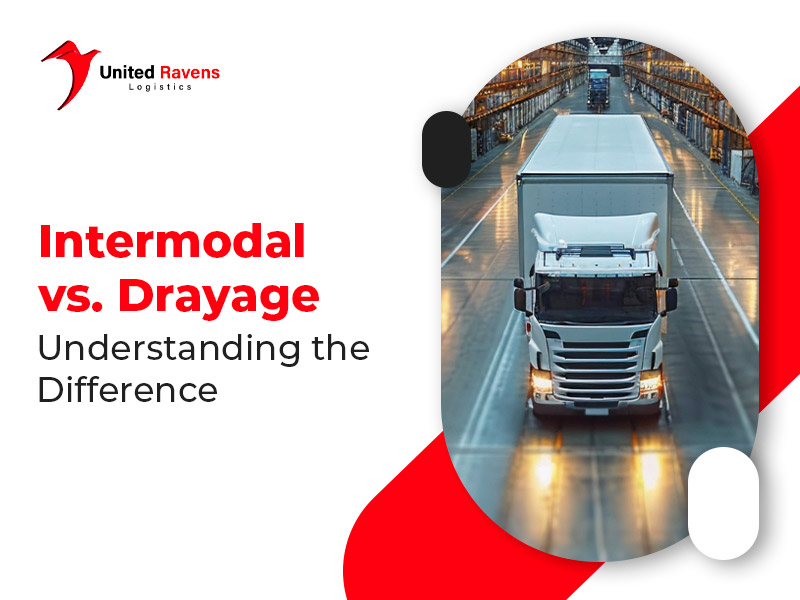In the logistics and transportation world, you must have heard the two names ‘Intermodal’ and ‘Drayage.’ These two are an important part of the supply chain. You might be curious, what exactly are they and their role in the supply chain?
Intermodal and Drayage both have their purpose, which they fulfill in the daily operations of the logistics world. This blog will explain the core difference between intermodal and Drayage.
What is Intermodal Transportation?
Intermodal transport uses more than one type of transportation to move goods from the beginning to the destination. Different types of Intermodal Transports are truck, rail, and ship.
Intermodal shipping is unique because it allows cargo to be transferred between these modes without handling the actual contents. For instance, a container can be loaded onto a truck, transported to a rail terminal, placed on a train, and later transferred to a ship while all the goods remain untouched. This seamless transfer process helps reduce the risk of damage and speeds up delivery times.
What is Drayage Transportation?
Drayage transportation refers to the short-distance movement of goods, typically from a port to a nearby warehouse, rail terminal, or distribution center. It’s a crucial part of the shipping process, as it helps bridge the gap between larger transportation modes like ships or trains and local delivery methods.
For example, when a shipping container arrives at a port, drayage services providers transport it to a nearby location for unloading or further transport. Though it involves short trips, drayage plays an essential role in the supply chain by ensuring that goods quickly move from one point to the next.
It is an essential part of the logistics supply chain that connects different modes of transport. Thus, creating efficiency and maintaining proper flow of supply.
What is the Difference Between Intermodal and Drayage?
Intermodal and Drayage are important but serve different parts of the shipping process. Let’s know more about intermodal vs drayage and understand what makes them different from each other in the table below:
| Aspect | Intermodal | Drayage |
| Distance Covered | It covers long distances, often across regions or countries. | It covers small distances, often nearby destinations within the city. |
| Modes of Transport | It combines various modes of transport such as trucks, air, rail, and sea. | It primarily uses trucks for transportation. |
| Cost Efficiency | It is cost-effective as it utilizes different modes of transport best suited for long hauls. | It does not focus on cost-effectiveness, as it requires frequent runabouts. |
| Operational Area | It mainly covers all the areas of transportation, including land, air, sea, and road. | Transportation takes place via trucks, and it involves only the road. |
| Environmental Impact | It has less impact on the environment as it utilizes all modes of transport effectively for long distances. | It has a high negative environmental impact as it continuously takes small hauls multiple times. |
| Coordination complexity | Coordination is the primary factor for intermodal work. Thus, a high level of coordination. | It only focuses on individual transportation for a local haul. Thus, there is a low level of coordination. |
| Flexibility | Flexibility is relatively less as it involves multiple modes of transport, making it fragile to changes. | Flexibility is high as it involves only a truck. Thus, last-minute changes won’t lead to any drastic loss. |
How Do Intermodal and Drayage Work Together?
Intermodal and drayage can complement each other with effective coordination. Companies can integrate intermodal with drayage to optimize their supply chains more flexibly. Intermodal is cost-effective for moving long routes, and drayage provides a local connection to the shipment’s delivery.
For example, goods can be transported nationwide on rails in a uniform container. When this long-distance journey is complete, the rest of the short distance is moved by drayage. The containers are transferred from rail yards or ports to local distribution centers or the destination via drayage trucks. Such a combination allows goods to be moved efficiently over long and short distances by playing off the relative strengths of each method.
This collaboration helps manage the overall costs of logistics and increase the speed and reliability of delivery. In other words, intermodal sets up the efficient long-haul journey, while drayage fine-tunes local distribution, making them a strong team that reinforces the overall performance of a modern supply chain.
Conclusion
Intermodal is used for long routes, whereas drayage is used for short routes within the city routes. It is concluded that technically, drayage is not a separate entity but a part of intermodal transport.
Utilizing both of them strategically can reduce costs and improve overall efficiency in logistics. If you need both of these services for your business, it’s better to get these services from a single place like United Ravens. We can efficiently take care of all your shipping needs.
Read also this: https://unitedravens.com/intermodal-vs-truckload-shipping-which-is-better-for-your-business/

